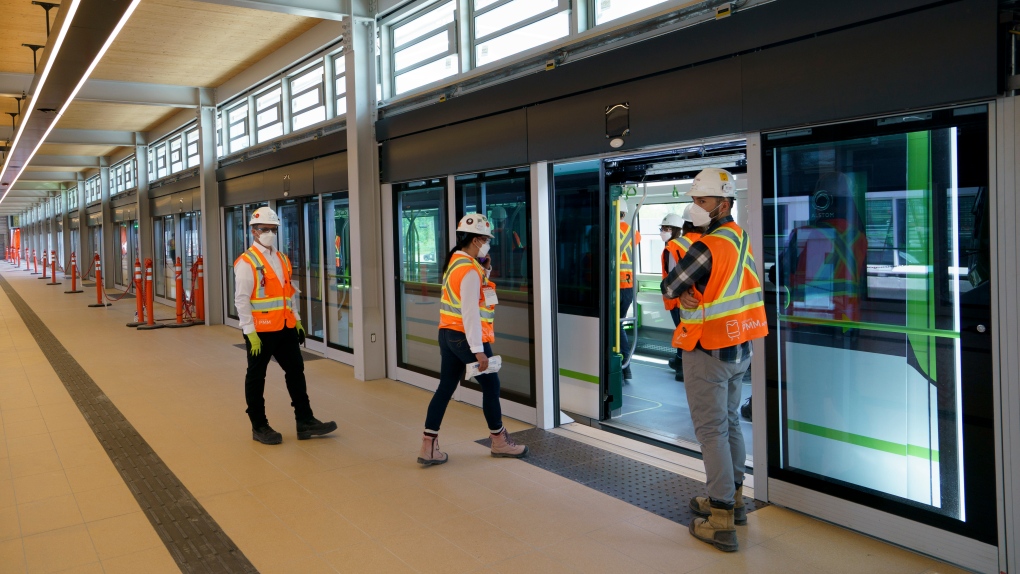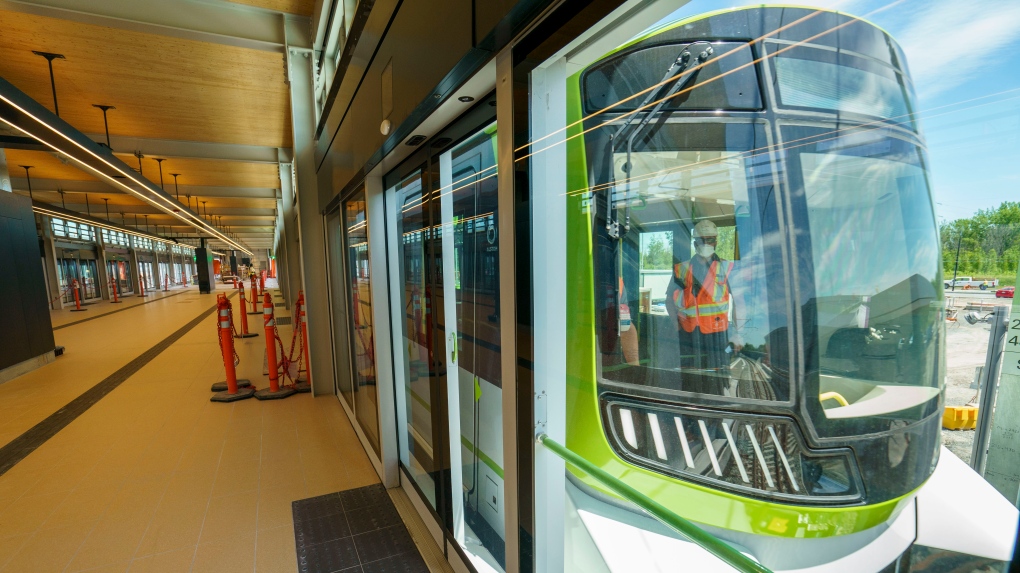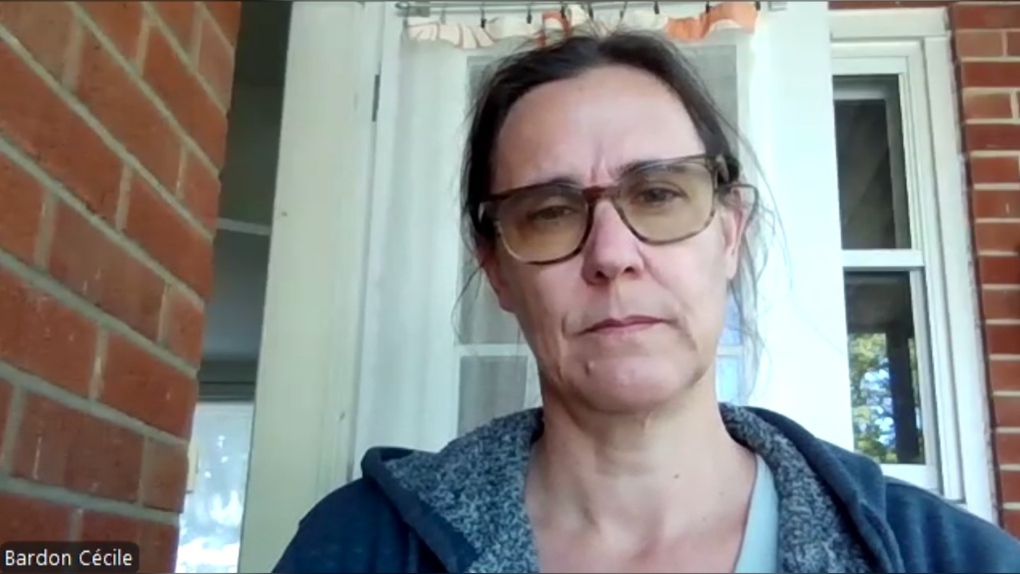Despite continued pleas from coroners, Montreal metro not proceeding with platform screen doors any time soon
Warning: This story contains details about suicide.
Montreal's transit authority said it has no immediate plans to implement platform screen doors on the metro despite repeated pleas from Quebec coroners who say the safety barriers can prevent suicides and assurances from the province that the costs to install them would be covered.
The city's new light rail line, the Réseau express métropolitain (REM), opened to the public in July 2023 and was the first public transit system of its size in North America to install the safety barriers at all of its stations. The automated barriers span the length of the platform and only slide open when the train has arrived and is stopped at the station, preventing people or objects from entering the tracks.
But none of the stations in the city's much larger metro network have such structures. As recently as last year, a coroner urged the Société de transport de Montréal (STM) to install them after a passenger entered the Berri-UQAM station one day in January 2023 during the morning rush hour and died by suicide.
She was 12 years old.
"[The girl's] death caused by the collision with the metro train could have been avoided if platform doors had been in place," wrote Coroner Karine Spénard in her investigation report obtained by CTV News.
 A worker inspects the platform screen door installed at a REM station in Greater Montreal. The doors slide open when the train arrives and is stopped in the station. (Source: REM/YouTube)
A worker inspects the platform screen door installed at a REM station in Greater Montreal. The doors slide open when the train arrives and is stopped in the station. (Source: REM/YouTube)
In her report, Spénard noted the dozens of suicides that have happened in the past several years in the metro and that, "Each of these events was the subject of a coroner's report, and in several of these reports, it was recommended that doors be installed to limit access to the metro tracks."
"To better protect human life, I will therefore recommend that the Société de Transport de Montréal pursue its plan to install platform doors. I discussed this recommendation with a representative of the Société de Transport de Montréal, who welcomes it," the report stated.
The coroner also recommended Quebec's transport ministry "provide the appropriate funding so that the Société de Transport de Montréal can proceed with the installation of platform doors in all metro stations."
Provincial programs would cover up to 100 per cent of costs
The formal recommendation after the young girl's death has not made the STM move any quicker on the file, even though there's a government assistance program that would help pay for it.
 Members of the media enter a train during a media tour of the the Reseau express metropolitain (REM) in Brossard, Que. on Thursday, June 10, 2021. THE CANADIAN PRESS/Paul Chiasson
Members of the media enter a train during a media tour of the the Reseau express metropolitain (REM) in Brossard, Que. on Thursday, June 10, 2021. THE CANADIAN PRESS/Paul Chiasson
The Ministère des Transports told CTV News that there are three public transit capital assistance programs available that would cover the entire cost of the purchase and installation of the platform screen doors in the Montreal metro.
In fact, ministry spokesperson Sarah Bensadoun said in an email that the rate of financial aid for metro development projects, including the safety barriers, "has been raised from 75% to 100% under the Programme d'aide gouvernementale au transport collectif des personnes," which is one of those programs.
A spokesperson for the STM said it had previously studied the platform doors project but prioritized other modernization projects on the network instead because of the "difficult financial parameters" the transit agency faced following the pandemic.
Amélie Régis said in an email that the STM has earmarked $5 million to study the project "around 2032" as part of its 2024-2033 investment program.
 A train rolls into a station during a media tour of the the Reseau express metropolitain (REM) in Brossard, Que. on Thursday, June 10, 2021. THE CANADIAN PRESS/Paul Chiasson
A train rolls into a station during a media tour of the the Reseau express metropolitain (REM) in Brossard, Que. on Thursday, June 10, 2021. THE CANADIAN PRESS/Paul Chiasson
Retrofitting every station would likely be a complicated and costly endeavour. A REM spokesperson declined to disclose how much it cost to install the Alstom platform screen doors in its network. As for the metro, the STM says its future study would help provide an estimate of the overall cost.
When asked about the financial aid programs the government offers for the platform doors project, the STM pointed to an overall lack of adequate funding from Quebec for maintaining its assets, making it more difficult to move forward with new projects.
"The Plan québécois des infrastructures 2024-2034 (PQI) provides for investments in maintaining public transport assets of $2.4 billion, the lowest level since 2013 … these investments represent only 41% of the sums that were available in 2013. And our asset maintenance programmes have not been included in the PQI," Régis said.
"Our annual needs for asset maintenance are some $560 million (metro alone). Knowing this, we have to prioritize certain projects to the detriment of others in order to keep the metro network safe."
The STM decided to backtrack on plans to retrofit 13 stations on the orange line with the platform screen doors even when the province had committed to covering 75 per cent of the cost, the Montreal Gazette reported in July 2022.
The newspaper reported at the time that among the stations that would have been part of the project was Cremazie, where, in 2020, a 20-year-old man had died after falling onto the tracks while intoxicated. It also stated that the coroner who examined the man's death had recommended the STM install the safety platform barriers and that, despite a letter from the province urging the STM to reconsider axing the project, the transit authority went ahead and cancelled it anyway, citing pressure to cut costs.
92 suicides in the metro in last nine years
Several cities around the world have installed the barriers in their underground subway systems, including Paris, Stockholm, Tokyo, London, and Melbourne. They are widely viewed as an effective tool to prevent not only suicides, but also to prevent objects from falling onto the tracks and causing disruptions.
 Platform screen doors were installed in the metro in Melbourne, Australia. (Source: vic.gov.au)
Platform screen doors were installed in the metro in Melbourne, Australia. (Source: vic.gov.au)
The 12-year-old girl's death last year was one of nearly 100 suicides in the Montreal metro in the last nine years. According to statistics provided by the coroner’s office, there were 92 suicides in the metro between 2015 and 2023 in stations spanning the entire network. The figures point to an apparent decrease in suicides over the years, with 13 recorded in 2015 and six recorded in 2023.
The coroner's numbers do not take into account the number of suicide attempts in the metro or the number of accidental deaths. On the latter, the STM told CTV News that between 2015 and 2023, there were 169 suicide attempts in the metro network. The number of STM employee interventions has also been rising, "which shows that our prevention initiatives are bearing fruit," Régis said. Between 2013 and 2023, there were 2,010 interventions that led to the prevention of suicide.
Prioritize doors for new lines, increase resources in the community: experts
Cécile Bardon, an expert in suicide prevention, said in an interview that the young girl's death is a tragedy because "we consider suicide as a preventable death that we can do something about before it happens."
While she said the platform screen doors are likely the best way to prevent someone from ending their life in the metro, she said she has some hesitations with the coroner's narrow, one-pronged approach.
"It stops the last step in the suicidal process of a person. It doesn't reduce anything that comes before it," said Bardon, professor in the Department of Psychology at Université du Québec à Montréal (UQAM) and associate director of the university's Centre for Research and Intervention on Suicide, Ethical Issues and End-of-life practices (CRISE).
A better suicide prevention strategy is "multi-dimensional," she said, meaning that it includes not just reducing access to the tracks but also providing appropriate mental health support in the metro system and in the community, reducing poverty, increasing social inclusion for disenfranchised communities, and better supporting teens in school.
"If [the coroner] had said there are many things that can be done at different levels of the continuum of prevention, I would be more comfortable because then it pushes different useful suicide prevention techniques that can be implemented — and should be implemented — and can be more easily done within the financial, social, mechanical, architectural means we have at the moment," Bardon said.
"That's a 20-year plan."
 Cécile Bardon is a professor in the Department of Psychology at Université du Québec à Montréal (UQAM) and associate director of the university's Centre for Research and Intervention on Suicide, Ethical Issues and End-of-life practices (CRISE). (CTV News)
Cécile Bardon is a professor in the Department of Psychology at Université du Québec à Montréal (UQAM) and associate director of the university's Centre for Research and Intervention on Suicide, Ethical Issues and End-of-life practices (CRISE). (CTV News)
Hugo Fournier, president and executive director of the Association québécoise de prévention du suicide, agrees that even though the barriers are proven to reduce suicides, they remain a costly and complex piece of equipment.
"Every suicide is one too many, and the death of a child by suicide is something that touches us very deeply as an organization working to prevent suicide," he said in a written statement.
"While the argument of the technical and financial challenges involved in the widespread installation of this type of device in existing stations is valid, the deployment of new lines or the extension of existing ones should, in our opinion, certainly offer more space for this option."
How the STM deals with people in distress in the metro
The STM said all of its employees and station managers receive suicide prevention training to detect concerning behaviour and report situations that can be dealt with quickly.
When the control room is notified of a person in distress, train operators are asked to enter the station at a reduced speed.
The STM also partnered with Centre de prévention du suicide de Montréal to set up posters near the ends of platforms offering assistance to someone who might need help.
It is also working with researchers on a new artificial intelligence (AI) project aimed at identifying certain behaviours on surveillance cameras so that systems can take action to prevent a suicide.
CTVNews.ca Top Stories

BREAKING Singh says the NDP 'will vote to bring this government down' in new letter
After months of being non-committal, in a new letter, NDP Leader Jagmeet Singh says his caucus 'will vote to bring this government down,' sometime in 2025.
WATCH LIVE 4 ministers get new portfolios, 8 Liberal MPs promoted in Trudeau cabinet shuffle
Prime Minister Justin Trudeau is adding eight Liberal MPs to his front bench and is reassigning four ministers in a cabinet shuffle currently underway in Ottawa.
Weather alerts in effect across Canada: Freezing rain, snow, extreme cold
Environment Canada has issued a series of winter weather alerts from Edmonton to St. John's as freezing rain, snow squalls and extreme cold blanket parts of the country.
Joss Stone says she's discovered she's pregnant – just weeks after adopting a baby
Joss Stone has revealed that she is pregnant, just weeks after she and her husband adopted a baby boy.
A new book about Chrystia Freeland just came out. Here's what we learned
A new book about Chrystia Freeland has just come out, after the publishing company sped up its release date by a few months. CTV News sifted through the book and pulled out some notable anecdotes, as well as insights about Freeland's relationship with the prime minister.
U.S. recalls 600K car seats, fix available to Canadians
Nuna Baby Essentials is recalling nearly 609,000 child car seats because the harness adjuster can loosen and the seats may not restrain children.
'Lowlifes': B.C. family outraged over theft of outdoor Christmas decorations
Security footage from a home in Vancouver’s Kerrisdale neighbourhood clearly shows a man grabbing Christmas decorations from the front lawn, and then casually walking away with them.
'Concerned, frustrated, in fear': Renewed calls for government to address antisemitism after third gunfire inside at Toronto Jewish school
A Jewish elementary school in Toronto has been struck by gunfire for the third time in the last seven months.
An onion or a ticket? 'Officer Grinch' surprises speeding drivers with unusual offer
Drivers in the Florida Keys who exceed the speed limit in school zones may run into a well-known gloomy green creature and get a surprising 'gift.'
































